Key takeaways:
- Model accuracy is not a single percentage; it requires consideration of other metrics like precision and recall for a comprehensive evaluation.
- Tuning hyperparameters can dramatically enhance a model’s performance, turning mediocre results into high accuracy.
- Feature selection and data quality are critical; pruning irrelevant data often leads to significant improvements in model accuracy.
- Collaboration and continuous feedback can uncover insights that enhance model effectiveness and accuracy.
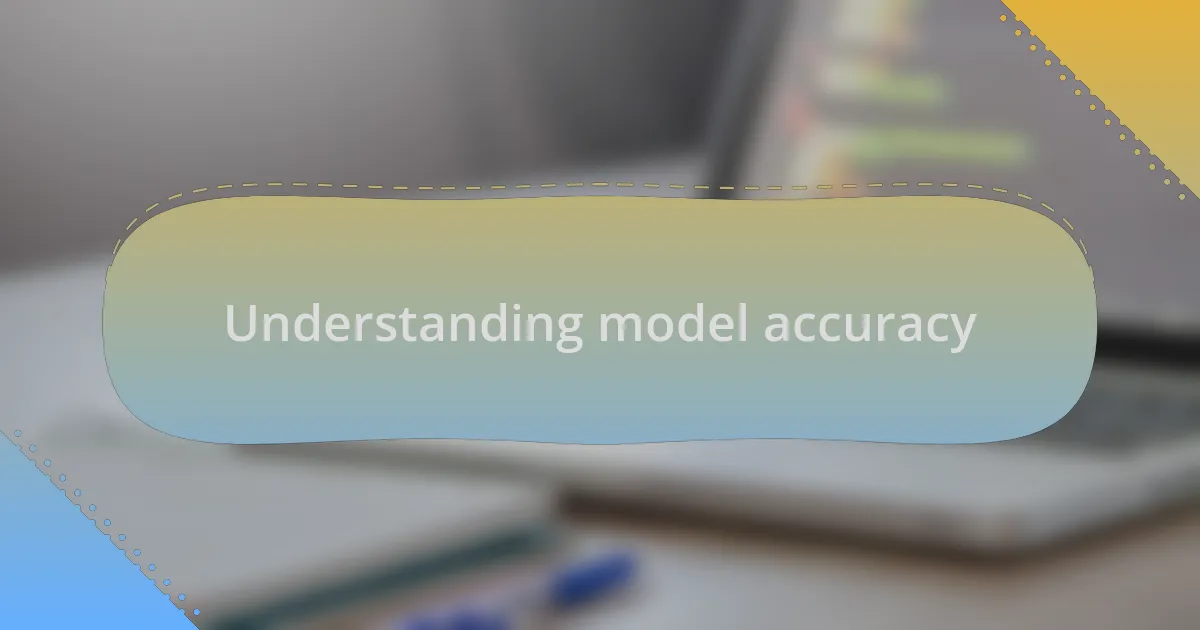
Understanding model accuracy
Model accuracy is essentially a measure of how often a model makes correct predictions. I remember when I first dove into model evaluation; I was overwhelmed by numbers and statistics. But then it hit me: accuracy isn’t just a single percentage. It reflects the model’s ability to generalize from training data to real-world applications.
I often find myself pondering, what does it mean for a model to be “accurate”? Is it about hitting the bullseye every time, or is there room for error? In my experience, understanding the nuances of model accuracy requires recognizing that a high accuracy doesn’t always equate to a high-performing model. For instance, a model might have an impressive figure on its accuracy score while still failing miserably on underrepresented classes in the dataset.
When I first started working on my predictions, I was enamored by models that boasted 90% accuracy. However, after digging deeper, I realized that the context is everything. Just because a model performs well overall doesn’t mean it’s effective for every scenario. This experience taught me the importance of evaluating accuracy alongside other metrics, such as precision and recall, for a more holistic view.
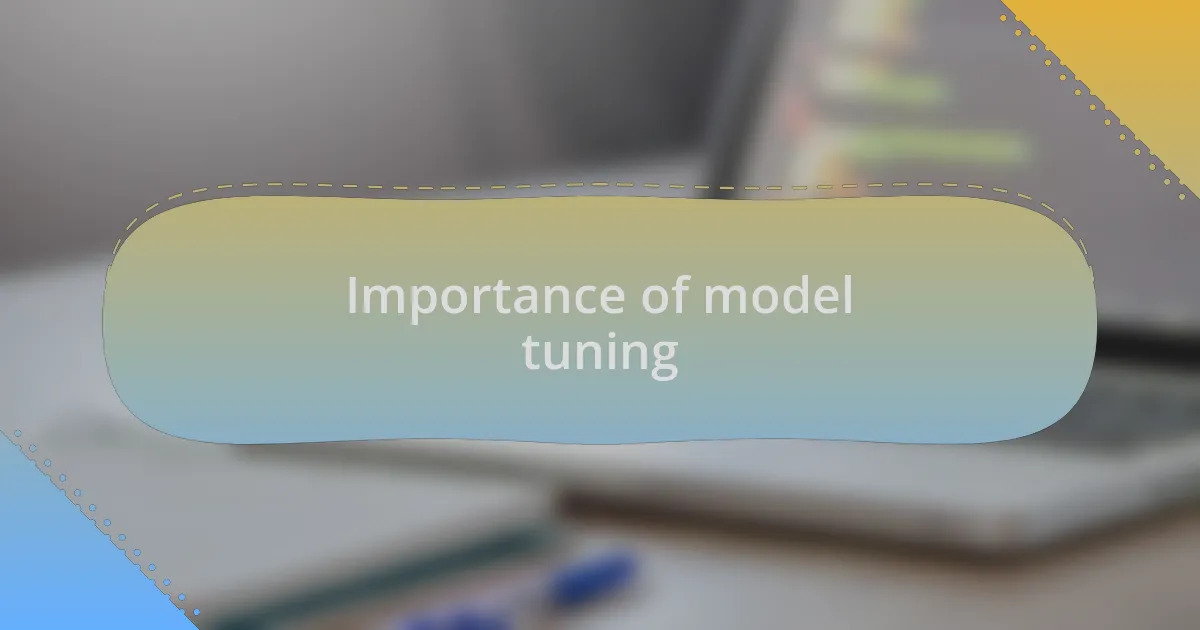
Importance of model tuning
Fine-tuning a model can significantly impact its accuracy. I remember the first time I adjusted the hyperparameters of a model; it was like discovering a hidden level in a game. Each small tweak would either boost my model’s performance or send it spiraling. It made me realize that tuning isn’t just a technical necessity; it’s an art form that can transform a mediocre model into something exceptional.
I’ve encountered situations where my initial model delivered decent accuracy, but after careful tuning, the improvement was staggering. One particular case involved a classification model that I worked on for a client. After adjusting the learning rate and regularization, I saw a jump from 75% to over 85% accuracy. How thrilling it was to witness the model’s ability to recognize patterns more effectively! This experience reinforced my belief that model tuning is crucial for unlocking a model’s full potential.
Effective model tuning not only enhances accuracy but also instills confidence in the predictive capabilities of the model. I often ask myself, how can I present findings to stakeholders without a model that truly performs? With the right tuning, I can stand firm behind the results, knowing that I’ve maximized the model’s abilities. In the end, it’s this confidence and accuracy that lead to better decisions and impactful solutions.
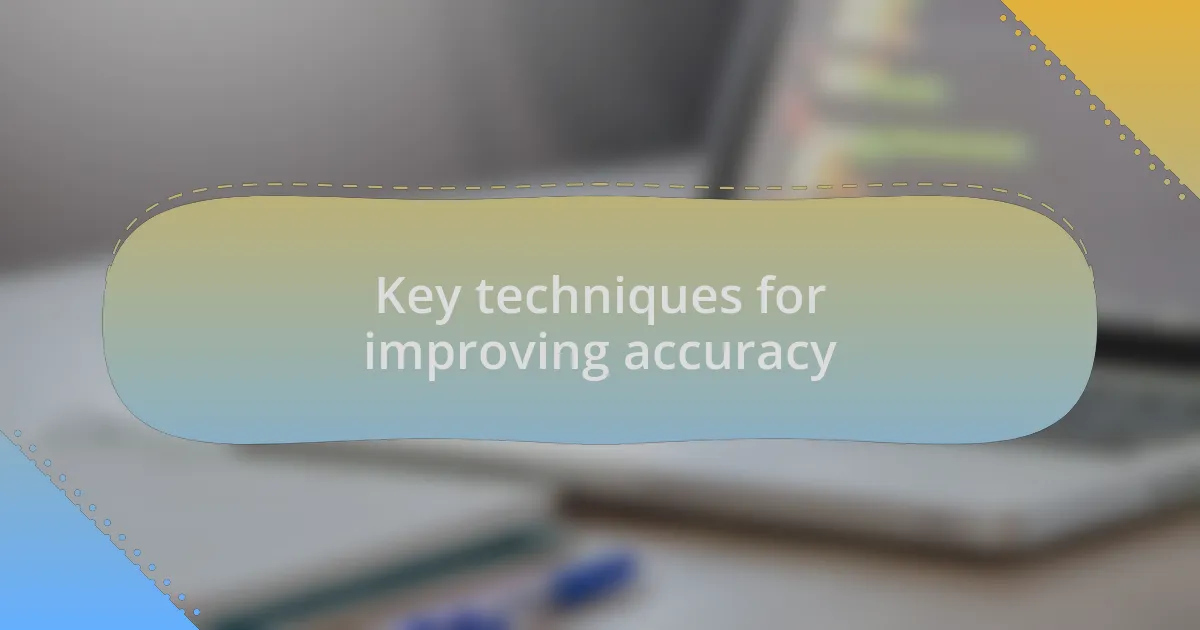
Key techniques for improving accuracy
When it comes to improving accuracy, feature selection can be a game changer. Early in my journey, I once worked with a dataset overwhelmed by irrelevant features. After narrowing it down to the most impactful ones, I felt like I had cleared a fog from my model’s vision. The accuracy soared, proving to me that it’s not always about having more data, but rather about having the right data.
Another technique that I’ve found invaluable is cross-validation. I vividly remember the first time I applied k-fold cross-validation to my models. Initially, I underestimated its importance and relied solely on a train-test split. Once I implemented it, the reliability of my accuracy estimates improved dramatically, revealing discrepancies I never would have noticed. Isn’t it satisfying to finally bridge the gap between training and real-world performance?
In my experience, adjusting model complexity is also crucial. I once struggled with overfitting, where my model performed beautifully on training data but faltered in practice. By simplifying the model architecture and implementing techniques like dropout, I watched it transform. This taught me that elegance in design can often lead to better, more generalizable results. How often do we prioritize complexity when simplicity could bring clarity?
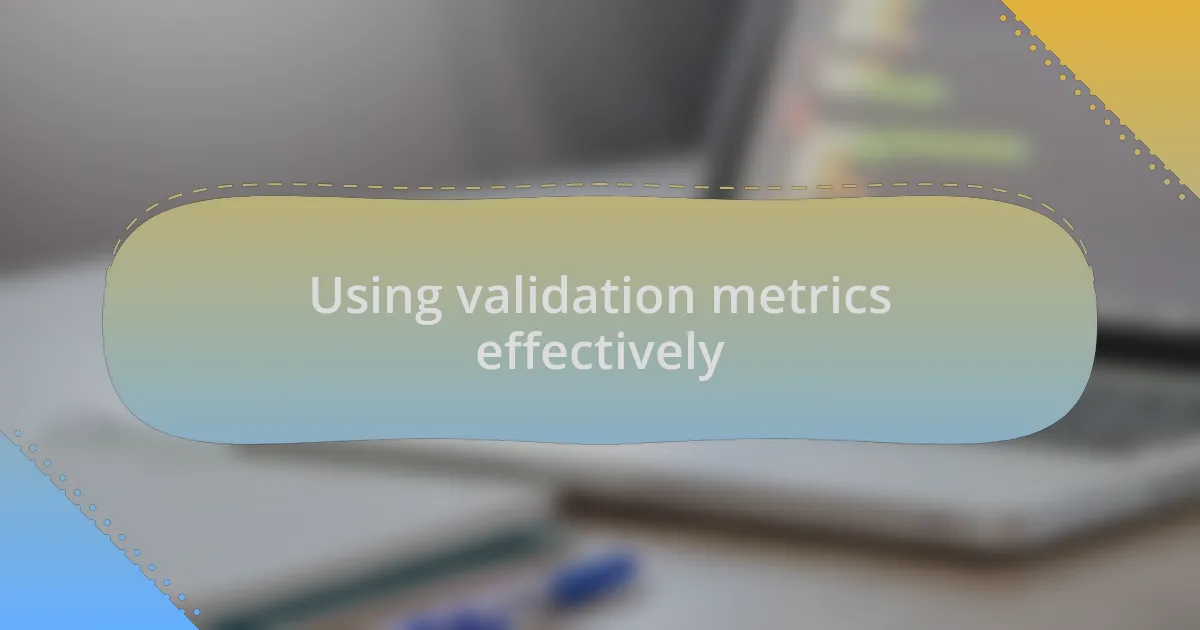
Using validation metrics effectively
When I started using validation metrics, my perception of model evaluation transformed. I remember a project where I relied heavily on accuracy, only to later discover precision and recall provided a deeper understanding of my model’s performance, especially in a skewed dataset. Why would we settle for a shallow interpretation when there’s so much more to uncover?
I also learned the significance of the confusion matrix in my journey. The first time I visualized one, it was like looking through a microscope at my model’s predictions. I was able to identify true positives, false positives, and false negatives, allowing me to pinpoint where I was going wrong. This clarity was eye-opening, highlighting that sometimes the issues lie where we least expect them.
Moreover, I realized that incorporating validation metrics into my workflow could foster a culture of constant improvement. I once set up a routine where every time I implemented a new feature or modified hyperparameters, I’d assess the changes using various metrics. This iterative process created a feedback loop, making it easier to celebrate small wins and learn from setbacks. How often do we take the time to reflect on our model’s performance in this way?
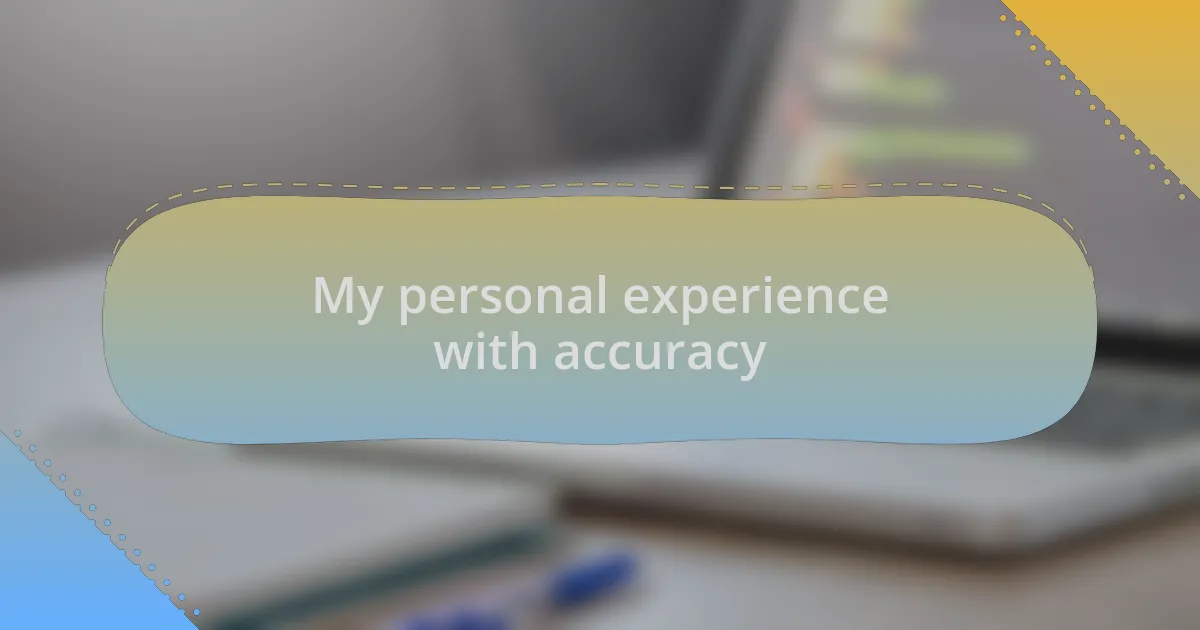
My personal experience with accuracy
As I delved deeper into model accuracy, I realized that my first experiences were often filled with frustration. In one project, despite achieving a high accuracy score, my model’s real-world performance left much to be desired. I vividly recall the sinking feeling when I presented my findings only to be met with skepticism. It made me reconsider: what does accuracy truly mean if it doesn’t reflect real-world results?
Another turning point was when I started experimenting with different algorithms. I remember grappling with decision trees and randomly encountering a striking drop in accuracy when the dataset lost some features. It was perplexing at first. How could something so seemingly simple bring my work crashing down? This experience taught me that accuracy isn’t just a static number; it changes with every new addition or tweak, and it’s crucial to remain vigilant.
I soon embraced a more nuanced perspective, understanding that accuracy is a journey rather than a destination. One time, while collaborating on a challenging project, I celebrated a small increase in F1 score, knowing it indicated a more balanced model performance. That moment filled me with renewed motivation. It made me question how often we overlook the importance of these metrics in favor of a single accuracy figure. Have you ever paused to truly appreciate the intricacies that accompany our success?

Lessons learned from real projects
In tackling real projects, I learned that the data quality often trumps the complexity of the model. During one project, I spent weeks fine-tuning a sophisticated neural network, only to realize that poor data quality was at the root of my performance issues. It was a frustrating revelation, but it underscored an important lesson: sometimes the simplest solution is to focus first on clean, relevant data before diving into complex algorithms.
I also discovered the value of collaborative feedback. While working on a predictive modeling task, I reached out to colleagues to discuss potential blind spots in my approach. Their insights opened my eyes to aspects I had overlooked, such as the importance of feature selection. This experience made me appreciate how communication and sharing perspectives can enhance model accuracy—after all, two heads are better than one, right?
Lastly, I’ve come to understand that initial setbacks can often lead to the most significant breakthroughs. In one instance, a model I thought was working ended up underperforming after deployment. Initially, my intuition told me to abandon it completely. However, after a few tweaks and greater experimentation, it evolved into a reliable tool. Have you ever faced a similar situation? Sometimes, persistence can reveal improvements that a quick exit would miss.
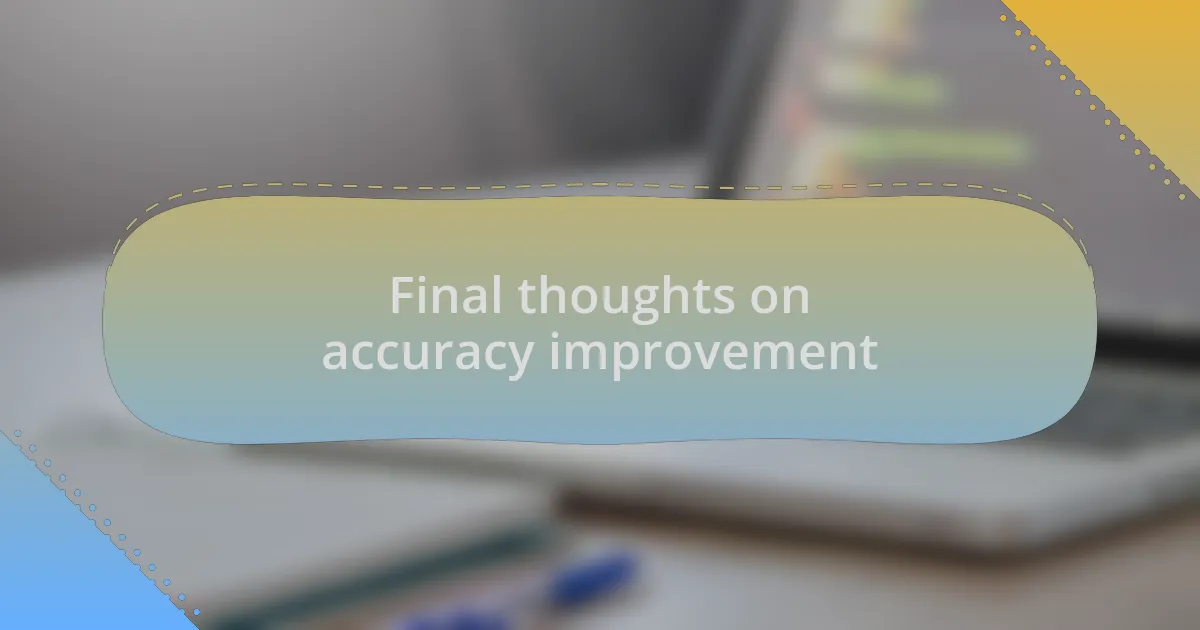
Final thoughts on accuracy improvement
Improving model accuracy is often a journey of trial and error. I remember a project where I was convinced that adding more features would enhance performance. It wasn’t until I stripped the model down to its core elements that I truly saw an improvement. Isn’t it fascinating how sometimes less really is more?
I’ve also learned that tuning hyperparameters is like adjusting the dials of an intricate machine. Initially, it felt overwhelming to navigate, but with each iteration, I started to see patterns emerge. This made the process not just a technical task but an exciting puzzle. Have you had a moment where you discovered a simple tweak made a significant difference?
Ultimately, the pursuit of accuracy is deeply tied to understanding the problem you’re solving. I often reflect on how engaging with the end-users can illuminate their needs, guiding my adjustments. This connection has taught me that the best improvements come not just from data analysis, but also from empathy and awareness of the real-world applications of my models. Isn’t it rewarding to create something that resonates with users?